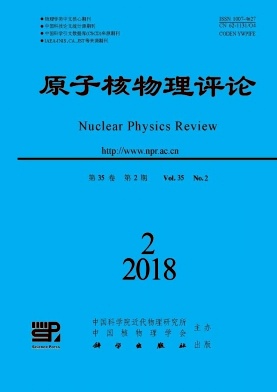|
[1]
|
CWIOK S, HEENEN P H, NAZAREWICZ W. Nature, 2005, 433:705. |
|
[2]
|
SOBICZEWSKI A, POMORSKI K. Progress in Particle and Nuclear Physics, 2007, 58:292. |
|
[3]
|
LU Bingnan, ZHAO Enguang, ZHOU Shangui. Physical Review C, 2012, 85:011301(R). |
|
[4]
|
SOBICZEWSKI A. Journal of Physics G:Nuclear and Particle Physics, 2016, 43:095106. |
|
[5]
|
OGANESSIAN Y T, UTYONKOV V K. Nuclear Physics A, 2015, 944:62. |
|
[6]
|
WANG Y Z, Wang S J, HOU Z Y, et al. Physical Review C, 2015, 92:064301. |
|
[7]
|
LI Baoan, CHEN Liewen, KO Mingche. Physics Reports, 2008, 464:113. |
|
[8]
|
LIU Min, WANG Ning, LI Zhuxia, et al. Physical Review C, 2010, 82:064306. |
|
[9]
|
DANIELEWICZ P, LEE J. Nuclear Physics A, 2014, 922:1. |
|
[10]
|
JIANG H, WANG N, CHEN Liewen, et al. Physical Review C, 2015, 91:054302. |
|
[11]
|
WANG Ning, LIU Min, OU Li, et al. Physics Letters B, 2015, 751:553. |
|
[12]
|
MOLLER P, MYERS W D, SAGAWA H, et al. Physical Review Letters, 2012, 108:052501. |
|
[13]
|
MOLLER P, NIX J R, MYERS W D, et al. Atomic Data and Nuclear Data Tables, 1995, 59:185. |
|
[14]
|
WANG Ning, LIU Min, WU Xizhen. Physical Review C, 2010, 81:044322. |
|
[15]
|
MO Qiuhong, LIU Min, WANG Ning. Physical Review C, 2014, 90:024320. |
|
[16]
|
LIU Min, WANG Ning, DENG Yangge, et al. Physical Review C, 2011, 84:014333. |
|
[17]
|
WANG Ning, LIANG Zuoying, LIU Min, et al. Physical Review C, 2010, 82:044304. |
|
[18]
|
WANG Ning, LIU Min, WU Xizhen, et al. Physics Letters B, 2014, 734:215. |
|
[19]
|
WANG Ning, LIU Min. Chin Sci Bull, 2015, 60:1145. (in Chinese) (王宁, 刘敏. 科学通报, 2015, 60:1145.) |
|
[20]
|
GORIELY S, SAMYN M, PEARSON J M. Physical Review C, 2007, 75:064312. |
|
[21]
|
GORIELY S, CHAMEL N, PEARSON J M. Physical Review Letters, 2009, 102:152503. |
|
[22]
|
DUFLO J, ZUKER A P. Physical Review C, 1995, 52:R23. |
|
[23]
|
WANG Meng, AUDI G, KONDEV F G, et al. Chinese Physics C, 2017, 41(3):030003. |
|
[24]
|
CHEN Menghua, LIU Min, WANG Ning. Journal of Guangxi Normal University(Natural Science Edition), 2018, 36(1):1. (in Chinese) (陈梦华, 刘敏, 王宁. 广西师范大学学报(自然科学版), 2018, 36(1):1.) |
|
[25]
|
WANG Ning, LIU Min, JIANG H, et al. Physical Review C, 2015, 91:044308. |
|
[26]
|
GAO Y, DOBACZEWSKI J, KORTELAINEN M, et al. Physical Review C, 2013, 87:034324. |
|
[27]
|
ERLER J, REINHARD P G. Journal of Physics G:Nuclear and Particle Physics, 2015, 42:034026. |
|
[28]
|
ROCA-MAZA X, PAAR N, COLO G. Journal of Physics G:Nuclear and Particle Physics, 2015, 42:034033. |
|
[29]
|
YUAN Cenxi. Physical Review C, 2016, 93:034310. |
|
[30]
|
WANG Ning, LIU Min, WU Xizhen, et al. Physics Letters B, 2014, 734:215. |
|
[31]
|
WANG Meng, AUDI G, WAPSTRA A H, et al. Chinese Physics C, 2012, 36(12):1603. |
|
[32]
|
LIU Min, GAO Yu, WANG Ning. Chinese physics C, 2017, 41(11):114101. |






 甘公网安备 62010202000723号
甘公网安备 62010202000723号 DownLoad:
DownLoad: